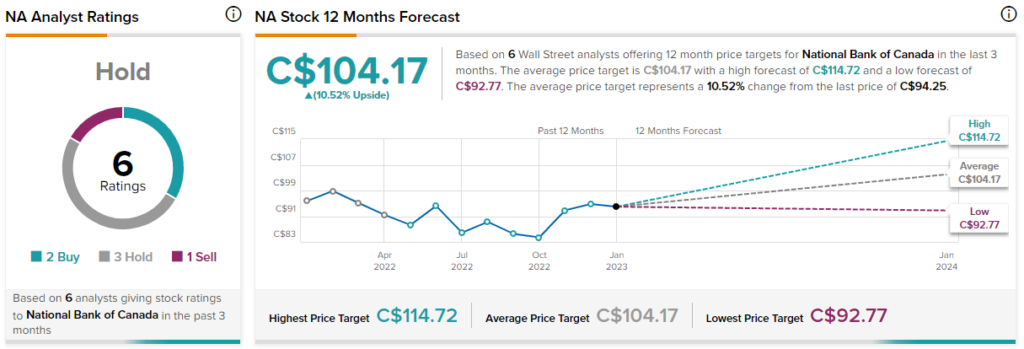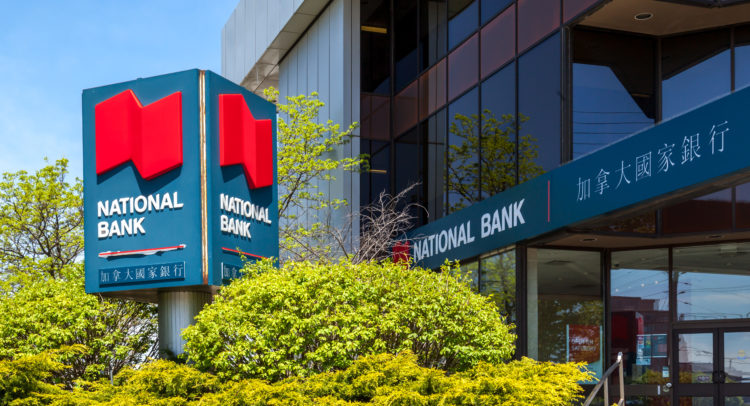National Bank of Canada (TSE:NA) (OTC:NTIOF), the smallest of the “Big Six” Canadian banks, has been relatively strong in the past 12 months, only down 0.6% (adjusted for dividends) compared to the S&P 500’s (SPX) loss of 15%. With a 4.25% dividend yield and a 9.7x P/E ratio, is NA stock good for value investors to consider? The answer is yes, as it may have over 64% upside potential. Let’s look into why this is the case.

National Bank’s Solid Dividend History
National Bank of Canada is a reliable dividend payer. It has grown its dividend at a 9.7% compound annual growth rate (CAGR) in the past five years and a 10.6% CAGR in the past three years. Since the dividend is already juicy at a forward yield of 4.25% (4% trailing yield), its growth rate is decent.
Also, NA only paid out about 36.8% of its earnings as dividends in the past 12 months (with a ~45% five-year average payout ratio), meaning that its payout is safe and has plenty of room for growth if the company chooses to grow it. In its latest earnings call, management said that they plan on getting the payout ratio back to between 40% and 50%, meaning that more dividend increases could be on the way.
Notably, the company didn’t cut its dividend during the Great Financial Crisis or the pandemic, highlighting its stability.
National Bank Stock is Undervalued: Here’s the Proof
To value NA stock, we will use the excess returns model, which is more appropriate for financial companies because they tend to have volatile free cash flows.
As a result, trying to create forecasts for them doesn’t work well. The excess returns model allows us to use historical numbers instead, which are tangible. There are a few steps to follow for this valuation method.
First, you calculate a company’s excess return, meaning the spread between its return on equity (ROE) and its cost of equity; a higher ROE than the cost of equity is a good thing. Next, you calculate its terminal value. Add them up, and you get your valuation. Here’s the formula:
- Excess Return = (Average ROE – Cost of Equity) x Book Value Per Share
- Terminal Value = Excess Return / (Cost of Equity – Growth Rate)
- Fair Value = Book Value Per Share + Terminal Value
We will use the following assumptions for our calculations:
Average return on equity (ROE): 17.6% (five-year average)
Cost of equity: 8.6%
Book value per share: C$59.70
Growth rate: 3.1% (used 30-year Government of Canada bond yield as a proxy for long-term growth expectations)
Now that we have our assumptions, we’ll plug them into the formula highlighted above. The figures are in Canadian dollars:
- $5.373 = (0.176 – 0.086) x $59.70
- $97.69 = $5.373 / (0.086 – 0.031)
- $154.97 = $97.69 + $57.28
Therefore, NA stock is currently worth about C$154.97 per this valuation method. Its current share price is C$94.25, making it undervalued (64.4% upside potential).
Is NA Stock a Buy, According to Analysts?
According to analysts, NA stock comes in as a Hold based on two Buys, three Holds, and one Sell rating given in the past three months. Nonetheless, the average NA stock price target of C$104.17 implies 10.5% upside potential.

The Takeaway: Consider Buying NA Stock
While National Bank is the smallest of the Big Six Canadian banks, it’s a high-quality company. In fact, NA’s return on equity of 17.7% is better than Royal Bank of Canada’s (TSE:RY) 16.1%, showing that its operations are more profitable than Canada’s biggest bank. The stock is undervalued based on our valuation above, and its juicy dividend yield could keep growing at rates similar to its historical average in the long term, adding to investors’ returns.









